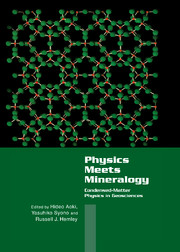Book contents
- Frontmatter
- Contents
- Preface
- List of Contributors
- Part I Introduction
- Part II Advances in Theoretical and Experimental Techniques
- Part III New Findings in Oxides and Silicates
- Part IV Transformations in Silica
- Part V Novel Structures and Materials
- Part VI Melts and Crystal–Melt Interactions
- Chapter 6.1 Comparison of Pair-Potential Models for the Simulation of Liquid SiO2: Thermodynamic, Angular-Distribution, and Diffusional Properties
- Chapter 6.2 Transport Properties of Silicate Melts at High Pressure
- Chapter 6.3 Structural Characterization of Oxide Melts with Advanced X-Ray-Diffraction Methods
- Chapter 6.4 Computer-Simulation Approach for the Prediction of Trace-Element Partitioning Between Crystal and Melt
- Subject Index
- Materials Formula Index
- Index of Contributors
Chapter 6.1 - Comparison of Pair-Potential Models for the Simulation of Liquid SiO2: Thermodynamic, Angular-Distribution, and Diffusional Properties
Published online by Cambridge University Press: 05 November 2011
- Frontmatter
- Contents
- Preface
- List of Contributors
- Part I Introduction
- Part II Advances in Theoretical and Experimental Techniques
- Part III New Findings in Oxides and Silicates
- Part IV Transformations in Silica
- Part V Novel Structures and Materials
- Part VI Melts and Crystal–Melt Interactions
- Chapter 6.1 Comparison of Pair-Potential Models for the Simulation of Liquid SiO2: Thermodynamic, Angular-Distribution, and Diffusional Properties
- Chapter 6.2 Transport Properties of Silicate Melts at High Pressure
- Chapter 6.3 Structural Characterization of Oxide Melts with Advanced X-Ray-Diffraction Methods
- Chapter 6.4 Computer-Simulation Approach for the Prediction of Trace-Element Partitioning Between Crystal and Melt
- Subject Index
- Materials Formula Index
- Index of Contributors
Summary
We extend a recent comparison of the abilities of different pair-potential models for SiO2 to reproduce the IR spectrum of the glassy state (a short-time dynamic property) to other properties. The comparison is extended to include static (thermodynamic and structural) and long-time dynamic (diffusivity) properties. As with the IR spectrum, none of the existing potentials succeeds in correctly locating the temperature of the density maximum Tp(max)- Although the modified Matsui potential, which best represented the IR spectrum, also performs well in describing Tp(max) and the intertetrahedral bond angle, it seriously overestimates the diffusivity and hence incorrectly represents the shape of the potential far from the minimum. The best performance across the range of properties examined is obtained with the van Beest–Kramer–van Santen potential. Some evidence for a higher-order phase transition below the density maximum is given.
Introduction
It is now two decades since it was found (unexpectedly to many) that key properties of liquid and glassy SiO2 could be reproduced semiquantitatively by molecular-dynamics (MD) computer simulations in which the Si and the O components are treated as simple ions with full formal charges [1]. The internal energy at 300 K was obtained to within 3%, and the qualitatively unique features of (1) high liquid compressibility contrasting with low liquid expansivity, (2) anomalous increase of diffusivity with pressure, and (3) large pressure-induced glass densification were also demonstrated.
- Type
- Chapter
- Information
- Physics Meets MineralogyCondensed Matter Physics in the Geosciences, pp. 325 - 339Publisher: Cambridge University PressPrint publication year: 2000
- 3
- Cited by



